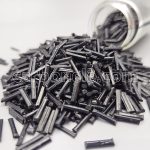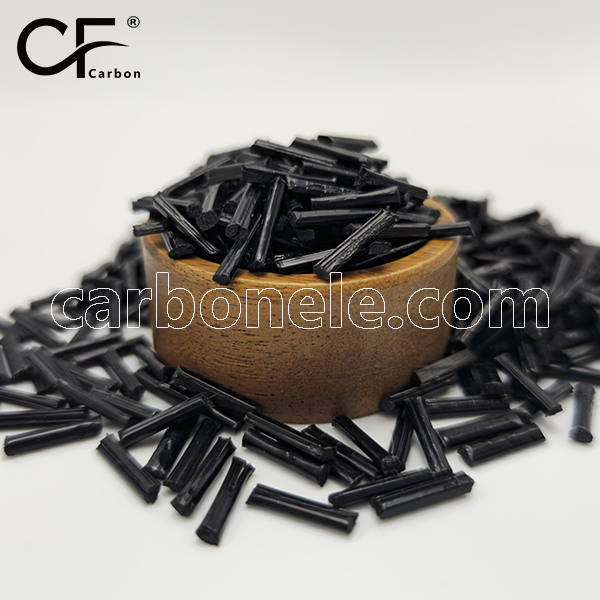
Good Quality PA66 LCF60 Compounds
PA66 LCF60 is a composite material comprising polyamide 66 (PA66) blended with 60% long carbon fibers (LCF). This combination enhances its mechanical properties, including tensile strength, stiffness, and durability. It finds applications in automotive, aerospace, and industrial sectors where lightweight materials with high performance are critical for structural components
- Model: PA66-LCF-BCA6
- Manufacturer: Yes
- MOQ: 1000kgs
- Free Sample: Available
- Molding Process: Injectioin /extrusion
- Color: Black
What’s PA66 LCF60?
PA66 LCF60 represents a state-of-the-art composite material that combines polyamide 66 (PA66) with 60% long carbon fibers (LCF), pushing the boundaries of mechanical performance, durability, and lightweight design in industrial applications.
This advanced composite is engineered to meet the stringent requirements of sectors such as automotive, aerospace, and industrial manufacturing, where superior strength-to-weight ratios and exceptional mechanical properties are critical for enhancing performance and efficiency.
**Polyamide 66 (PA66)** is a versatile thermoplastic known for its excellent mechanical properties, including high strength, toughness, and resistance to abrasion. It offers a balance of durability and ease of processing, making it suitable for a wide range of demanding applications across various industries.
**Long Carbon Fibers (LCF)** are composed primarily of carbon atoms and are renowned for their high strength-to-weight ratio, stiffness, and resistance to thermal expansion.
When integrated into polymer matrices like PA66, long carbon fibers enhance mechanical properties such as tensile strength, stiffness, and impact resistance, making them ideal reinforcements for high-performance composites.
Key Characteristics and Properties
1. **Exceptional Tensile Strength:** PA66 LCF60 exhibits significantly enhanced tensile strength compared to unfilled PA66, thanks to the incorporation of 60% long carbon fibers. This property enables the composite to withstand high mechanical loads and stresses, making it suitable for structural components in rigorous applications.
2. **High Stiffness and Rigidity:** The presence of long carbon fibers contributes to increased stiffness and rigidity in PA66 LCF60, improving dimensional stability and reducing the risk of deformation under load. This characteristic is crucial for maintaining structural integrity and ensuring precise fit and function in complex assemblies.
3. **Superior Lightweight Design:** Despite its enhanced mechanical properties, PA66 LCF60 remains lightweight. This weight reduction is particularly advantageous in industries such as automotive and aerospace, where reducing overall vehicle weight leads to improved fuel efficiency, performance, and payload capacity.
4. **Excellent Impact Resistance:** PA66 LCF60 maintains excellent impact resistance, even with its increased stiffness, making it suitable for applications subjected to sudden shocks or dynamic loading conditions. This property ensures durability and reliability in challenging operational environments.
5. **Chemical and Environmental Resistance:** The composite material exhibits good resistance to chemicals, oils, and environmental factors, ensuring long-term performance and reliability in diverse operating conditions. This property is beneficial for applications requiring durability and resilience in harsh environments.
Applications
PA66 LCF60 finds extensive use across various industries where high-performance materials are required to meet demanding operational challenges:
– **Automotive Industry:** Used in critical structural components such as chassis reinforcements, body panels, and engine mounts to enhance strength, stiffness, and crash resistance. PA6.6 LCF60 contributes to reducing vehicle weight while improving safety and durability in automotive applications.
– **Aerospace and Aviation:** PA 66 LCF60 is employed in aircraft structural components, including fuselage panels, wing assemblies, and interior fittings. Its high strength-to-weight ratio and resistance to fatigue contribute to enhanced aircraft performance, fuel efficiency, and operational reliability.
– **Industrial Manufacturing:** Applications include machinery and equipment components such as gears, bearings, housings, and conveyor systems. PA66 LCF60’s durability, wear resistance, and dimensional stability ensure reliable performance in industrial settings subjected to heavy loads and harsh operating conditions.
– **Renewable Energy:** Used in wind turbine blades, solar panel frames, and other renewable energy applications for its lightweight design and ability to withstand environmental stresses. PA66 LCF60 contributes to improving energy efficiency and reliability in sustainable energy production.
– **Marine and Offshore Applications:** PA66 LCF 60 finds use in boat and yacht components, offshore platform structures, and subsea equipment due to its corrosion resistance, durability, and lightweight properties. It enhances operational efficiency and longevity in marine environments.
– **Sports and Leisure Equipment:** Applications include sporting goods such as bicycle frames, tennis racquets, and ski components where lightweight materials with high strength and durability are essential for optimal performance.
Future Trends:
As industries continue to advance, PA66 LCF60 is poised to drive technological innovations and advancements in composite materials. Ongoing research focuses on optimizing manufacturing processes, exploring new fiber treatments, and expanding applications in emerging sectors such as aerospace, automotive lightweighting, renewable energy, and sustainable manufacturing practices.
Content Block 1
Morbi iaculis at quam vel faucibus. Ut semper ipsum ex, quis aliquet justo pretium a. Suspendisse scelerisque metus augue, a interdum leo iaculis sed. Vivamus sit amet nunc odio. Duis vel pulvinar dolor, at lacinia tellus.
Pellentesque habitant morbi tristique senectus et netus et malesuada fames ac turpis egestas. Suspendisse lacinia quam a elit lobortis tempor


Content Block 1
Morbi iaculis at quam vel faucibus. Ut semper ipsum ex, quis aliquet justo pretium a. Suspendisse scelerisque metus augue, a interdum leo iaculis sed. Vivamus sit amet nunc odio. Duis vel pulvinar dolor, at lacinia tellus.
Pellentesque habitant morbi tristique senectus et netus et malesuada fames ac turpis egestas. Suspendisse lacinia quam a elit lobortis tempor

Frequently Asked Questions
Carbon (Xiamen) New Material Co., Ltd. aims to provide buyers with "one-stop" worry-free high-quality services. Here you can find all information about carbon fiber engineering plastics. If you still have questions, please send us an email for consultation!
-
How can I contact the manufacturer of a product that interests me?
When you find a product you are interested in, you can contact the manufacturer directly by sending an email and we will get back to you as soon as possible.
-
How do I find the products that interest me?
All you need to do is enter the keyword, product name in the search window and press the Enter key on your keyboard. Your search results page will then be displayed. You can also search within the product category pages on the home page. Each category is divided into subcategories, allowing you to refine your search and find products that interest you.
-
Where will I find a buying guide?
Please contact our after-sales service directly and we will provide you with a comprehensive operating guide.
-
What are CF Reinforced Thermoplastic Composites?
CF Reinforced Thermoplastic Composites are materials where carbon fibers are incorporated into a thermoplastic matrix. They combine the strength and stiffness of carbon fibers with the processability and recyclability of thermoplastics. For instance, they are used in automotive parts like bumper beams.
-
What are the benefits of CF Reinforced Thermoplastic Composites over traditional composites?
The key benefits include faster production cycles, easier recyclability, and better impact resistance. They also offer design flexibility. An example is in the manufacturing of consumer electronics casings where complex shapes can be achieved more easily.
-
How are CF Reinforced Thermoplastic Composites processed?
Common processing methods include injection molding, extrusion, and compression molding. Injection molding is widely used for mass production. For example, in the production of small components for the medical industry.
-
What industries use CF Reinforced Thermoplastic Composites?
They are utilized in aerospace, automotive, medical, and sports equipment industries. In aerospace, they can be found in interior components. In the medical field, they might be used in prosthetics.
-
How does the carbon fiber content affect the properties of the composites?
Higher carbon fiber content generally leads to increased strength and stiffness but may reduce ductility. A moderate content is often balanced for specific applications. For example, a higher content might be preferred in structural parts of a race car.
-
What are the challenges in using CF Reinforced Thermoplastic Composites?
Challenges include higher material costs, complex processing equipment requirements, and ensuring uniform fiber dispersion. Issues with adhesion between the fibers and the matrix can also arise. An example is in achieving consistent quality in large-scale production.

























